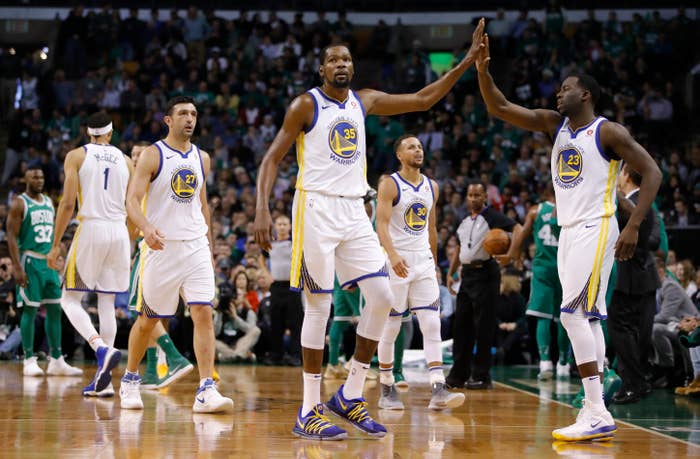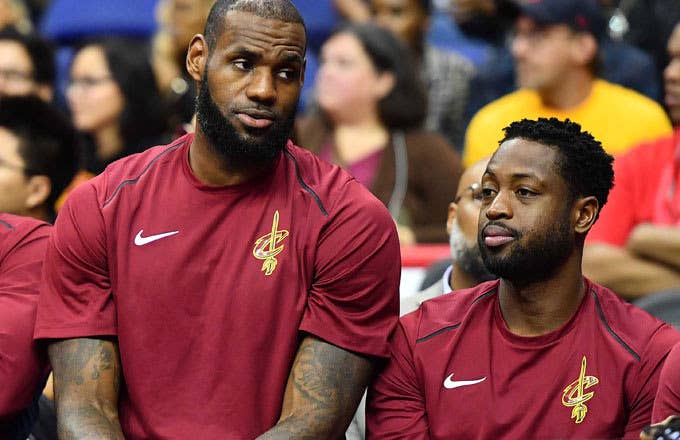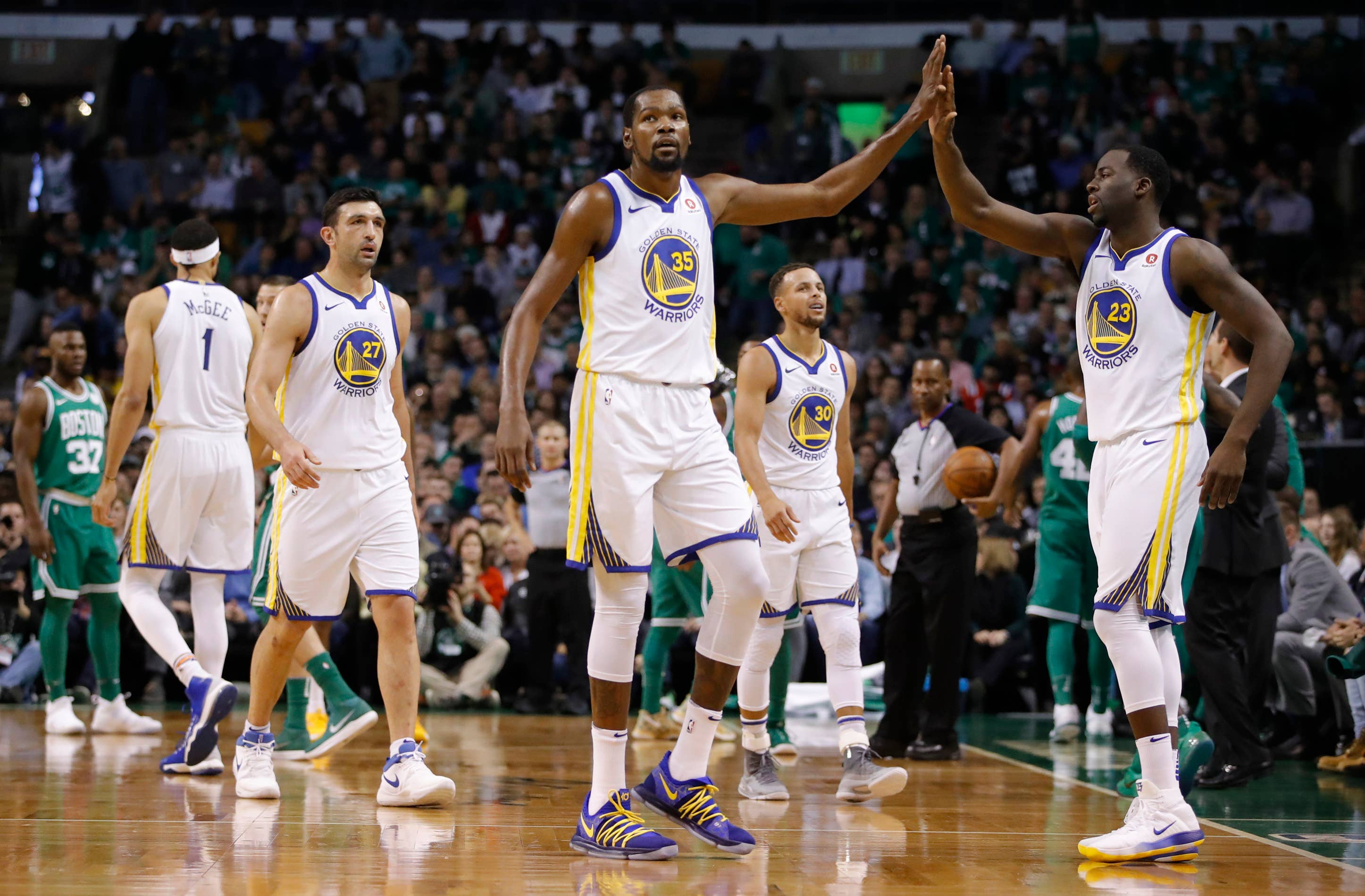
There’s a big reason ESPN and Turner Sports shelled out a record $24 billion over nine years to show NBA games. Live sports have become advertisers’ last refuge against on-demand videos and DVRs. But what if the result was preordained? What if everyone was Biff Tannen with their own Grays Sports Almanac? We would no longer be surprised as NBA fans.
That’s the existential problem facing the Association today: Every prognostication involves a Warriors footnote. And Golden State might just be the tip of the team-up iceberg.
With superstars joining forces in an effort to beat the Warriors, we may never again see a superstar—like Dirk Nowitzki in 2011—reach another level and click with a coach, system, and teammates on his way to NBA immortality. There will likely never be another dominant team like Rasheed Wallace, Chauncey Billups, Richard Hamilton, Ben Wallace, and Tayshaun Prince, who achieved more as a collective than as individuals when they overcame the odds against prime Kobe and Shaq in 2004.
That’s the fear of fans who watched the top teams in the NBA get even better this past summer, likely to no avail. Not only that, but the Eastern Conference’s singular Finals lodestone for the last seven years might be moving, too, turning another team into a possible Warriors slayer, while relegating the Cavs back to the lottery.
After ruining the holiday weekend for every basketblogger in the country as they awaited his free agency resolution, on July 4, 2016, Kevin Durant announced he would join the 73-win Warriors—the same team that came back from 3-1 down in the Western Conference Finals the month before to beat his Thunder. On paper, his signing created the best-ever team in NBA history, with two MVP’s in their prime, an All-NBA, two-way sharpshooter, and the soon-to-be Defensive Player of the Year.
Consequently, hot takes flew as everyone from hardcore analysts to NBA novices opined about the death knell of NBA competition. The gist of those takes was that the Larry O’Brien Trophy had been ceded in July because one guy from Mount Pleasant, Maryland decided to change employers. Except, this time the impulsive mob was right. KD clinched his first title and Finals MVP the next June, and the juggernaut everyone feared on July 4th calcified into reality. The NBA may never be the same again.
This past summer’s offseason fireworks were a direct result of Durant’s decision and Golden State’s easy path to the title. Teams knew they needed a serious talent upgrade if they were going to compete for a ring. Chris Paul left Lob City and finagled his way to James Harden and Houston; Carmelo Anthony and Paul George joined forces with KD’s former running mate and reigning MVP, Russell Westbrook. Gordon Hayward signed with Boston in free agency, and Kyrie Irving joined him later after a blockbuster trade with the Cavs. Teams lucky enough to land a superstar, added one or two more. These so-called super teams, for lack of a better expression, are the new normal in the NBA.
On that fateful July day in 2016 when KD—more so than Kim K or Nicki Minaj ever did—broke the internet, those of use old enough to remember, held off on pronouncements of competitive doom. We remembered LeBron James’ original Decision to join Chris Bosh and Dwyane Wade in the summer of 2010. We recalled the summer of 2013 when then-star Dwight Howard and former two-time MVP Steve Nash joined Kobe Bryant and SI put them on the cover of their preview issue as the ostensible frontrunners. Or, maybe we recollected the chaotic summer of 2003 when Kobe and Shaq’s Lakers acquired past-their-prime Karl Malone and Gary Payton. Some older Bean Town fans may have fallen into a reverie about the summer of 2007 when Danny Ainge acquired Ray Allen and Kevin Garnett to join up with Paul Pierce for an era that produced a title and two Finals appearances.
Super teams aren’t new, but the talent discrepancy between the teams at the top of the NBA hierarchy and everyone else is. Not only that, but the gulf last year between the Warriors and title contenders spurred this year’s action-packed summer, furthering the divide between the NBA’s haves and have nots.

Durant’s decision destroyed the days of the 2011 Mavericks or the 2004 Pistons. Yes, you could make the case LeBron’s Heat and Cavs’ teams, Tim Duncan’s Spurs, and the pre-KD Warriors were also loaded with enough talent to be a considered a “super team,” but not so much June champagne felt unavoidable. They were still pushed and challenged to achieve greatness and a chance to stand on the podium surrounded by confetti winners of the last game of the season.
LeBron James will again be a free agent in July, and many think he’s leaving Cleveland again. If James does, which star will he collaborate with to challenge the Warriors? Can the Warriors even be challenged? If he stays in Cleveland, will we be watching a Warriors-Cavs Finals matchup ad infinitum?
The new collective bargaining agreement allows teams to offer more money to keep a designated player. But because there’s still a maximum allowable on player salaries, stars will continue to band together in an effort to take down Golden State. It makes too much sense not to.
The biggest consequence of this new reality is we’ll no longer be astonished by who comes out on top. And isn’t the whole point of watching sports in the first place?


